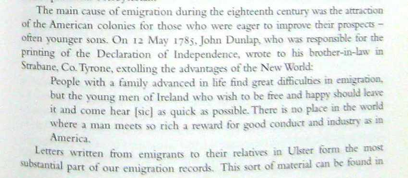Robert Kenney was born 8 March 1782 in Antrim County in Northern Ireland and died 6 October 1862 in Edgefield, South Carolina. He emigrated to the Charleston, South Carolina in Jan of 1790 or 1791 according to a statement he wrote in Oct 1840.
Was there an “American Wake”[5] for the family departing Antrim County? Did the villagers come to their home to dance and drink the night before the departure?
Robert arrived in the United States about the time the Bill of Rights was ratified, the first Bank of the United States was chartered (1791), and 3 years after South Carolina became ratified as the 8th state in the union (1788).
Why did his father decide to emigrate to South Carolina in the early 1790s? Emigration from Northern Ireland reached its peak in the 18th century with most being protestants and in particular, Presbyterians[1]. These Presbyterian’s seemed to be agitators who disliked the taxation on the land. Additionally, the growing population was causing the land holdings to be divided and it was harder to make a good living as a farmer. The Northern Irish had been the most outspoken in support of the colonists during their struggle with the mother country (Britian) and were among the most enthusiastic admirers of the French Revolution. While the attraction of America were many and well advertised, it’s likely the discontented were the ones willing to cut family ties and risk the Atlantic travel[2]. Hence it’s possible these were some of the the reasons for the Kenney’s leaving Northern Ireland.
The attraction of emigration to America appears to come from letters written from new settlers back home – an example is shown below[3] as well as from the ship captain’s hoping to fill their ships with paying passengers.
It’s also likely that Robert’s father descended from the Scottish who took refuge in Ulster (Northern Ireland), driven from Scotland by King James’ persecutions of the Presbyterians. These Scotch-Irish generally came from the South West parts of Scotland.
By the 1760s the flow of people from Ulster to the Carolinas was so great that Charleston displaced New York as the second most important port of destination of emigrant vessels. Philadelphia was #1. The Scotch-Irish passed through Charleston on their way to the NorthWest part of South Carolina – but still maintained links with Charleston for trade.[7]
Emigration of the Scotch-Irish to the Carolina’s as described in 1779 was “foreign Protestants from England and Scotland resorted to Carolina after the peace. But of all other countries none has furnished the province with so many inhabitants as Ireland. In the northern counties of that kingdom the spirit of emigration seized the people so much that husbandmen, laborers and manufacturers flocked over the Atlantic. As a result the Irish landlords began to be alarmed, and to concert ways and means for preventing the growing evil. Scarce a ship sailed for any of the plantations that was not crowded with men, women, and children. ….often crammed such numbers of them into their ships that they were in danger of being stifled during the passage, and sometimes were landed in such a starved and sickly condition, that numbers of them died before they left Charleston……Poverty and oppression will break through every natural tie and endearment, and compel men to rove abroad in search of some asylum against domestic hardship…..the SC governor and council met once a month for the purpose of granting lands and signing patents, and it is incredible what numbers of people attended those meetings in order to obtain them; so that from the time in which America was secured by the peace, Carolina made rapid progress in population, wealth, and trade” [4]
As the Scotch-Irish had settlements in Libery Spring, Laurens in 1785-90 and the Edgefield District in 1790 and the south Tyger river in 1791– it’s likely Robert’s father was emigrating to areas with people he knew or to a similar culture. [8]
If Robert landed in early 1790, we’d expect to find evidence of his family in the 1790 census. However, the only Kenney’s in South Carolina’s head of households from the first US Census in 1790 were a William Kinney of the Beaufort District and a John Kenney of the Charleston District[6]. Neither was married and John seemed to be a possible slave runner/broker. Thus, the likely immigration date is 1791.
[1] Tracing your Ancestors Northern Ireland by Ian Maxwell
[2] Aspects of Irish Social History 1750-1800 edited by W.H. Crawford and B. Trainer, 1969 , Her majestry’s stationary Office, Belfast. Introduction; Obtained from the Linen Library, Belfast.
[3] Tracing your Ancestors Northern Ireland by Ian Maxwell
[4] Historical Account of the Rise and Progress of the Colonies of South Carolina and Georgia by Alexander Hewatt, London 1779.
[5] Irish Family History, Marilyn Yurdan
[6] Ancestry.com search
[7] The Scots-Irish in the Carolinas by Billy Kennedy, Causeway press, Belfast 1997 from the Linen Library, Belfast, NI
[8] The Scotch-Irish or The scot in North Britain, North Ireland, and North America by Charles A. Hanna, Vol II CP Putnam, NY 1902 from the linen Library in Belfast pg 117
